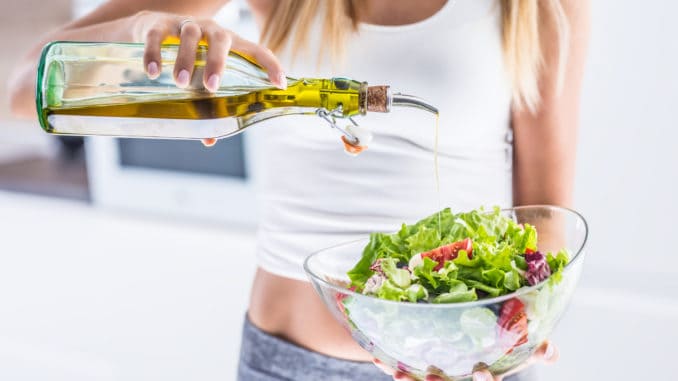
[cmamad id=”26811″ align=”center” tabid=”display-desktop” mobid=”display-desktop” stg=””]
Is it true that 70% of this food is fake?
—-Important Message From Our Sponsor—-
This will drop a 260-pound man in 2 seconds or less and turn him into a whimpering pile of flesh
Just press one button… And in two seconds, it will deliver absolute destruction to your enemy.
And it will potentially save your life and the lives of your loved ones.
You can carry it anywhere. Your wife can have it in her purse.
Your granddaughter can have it on her when she’s walking to her car at night in her school’s parking structure.
So what is it?
———-
This food is usually adulterated – maybe…
Olive oil is good for you (in teaspoon quantities) – but how do you know your olive oil is real?
Most olive oil is adulterated. Or that’s what we’ve been led to believe.
And this is believable because olive oil can be highly profitable.
But also because it is produced in Italy…
Apparently, the “agromafia” has an iron grip on the wine, olive oil, and cheese industries there…
…resulting in an explosion of “food crime.”
(And, allegedly, this is the actual mafia.)
According to some estimates, 70% to 80% of the olive oil from Italy is adulterated.
Although there are some attempts at detection going on, such as by the FDA, most of their findings never make it to the press…
And in most instances violators aren’t prosecuted or even fined.
Corporations always weasel out of these things simply by blaming their suppliers…
And the supplier in turn blames their suppliers…and so on.
According to author Tom Mueller, who has written a book and several articles on the topic:
“‘Profits were comparable to cocaine trafficking, with none of the risks,’ one investigator told me.”
And FDA officials are notoriously easy to bribe.
Although there are over thirty published scientific articles on all manner of detection efforts, not many of them tested commercial samples.
Most analytical reports merely used pre-adulterated samples…
The testers mixed the samples themselves in known proportions.
Then they later coded, randomized, tested, and then decoded to verify the technique.
The few articles that actually tested different commercial olive oil samples didn’t actually report their findings.
There could be many reasons for this. But it is probably enough to say that modern scientists don’t want to make waves…
Many (most?) scientists try to be good industry lap dogs so they can get future grants.
After all, most scientists are paid (at least in part) by either corporations or foundations set up by corporations.
So, thanks to the investigative reports of Tom Mueller and others, we know there is some degree of adulteration going on.
But it would be nice to have a reliable number…somewhat of a statistical risk factor to help us decide if buying olive oil is worth the risk.
At last, we’ve got a study from a public university in a democratic state that has a small olive oil industry to defend.
In 2011, U. Cal. Davis in California published the only real piece of hard evidence that helps answer our question.
And of course that question is: What percentage of olive oil on the shelves in stores today is actually adulterated?
“A total of 134 samples were analyzed by the research team.”
Really, as oils go, olive oil is not that bad.
It contains about 80% oleic acid and only between 5% and 10% linoleic acid – it’s certainly on the lower end of the linoleic acid range.

They tested 18 samples from 8 different brands – totaling 134 samples.
They collected these from grocery stores such as Walmart, Safeway, and a few regional California stores I have never heard of (Ralph’s, Von’s, Raley’s, etc).
For any “Rainman” out there who noticed that 18 × 8 = 144 and not 134, this is because one brand – Cobram Estate – was thinly stocked (only eight bottles available).
They assembled a panel of taste-testers… But this matters little since taste is highly subjective.
And it matters even less because the Californian testers would likely be biased on account of affiliation with local olive oil production.
But, regardless, they determined that 73% of the samples didn’t taste quite right.
More importantly, they used four different chemical-physical methods to test for six different olive oil properties.
Collaborators in Australia did two of these tests.
And the report only discussed the two Australian tests.
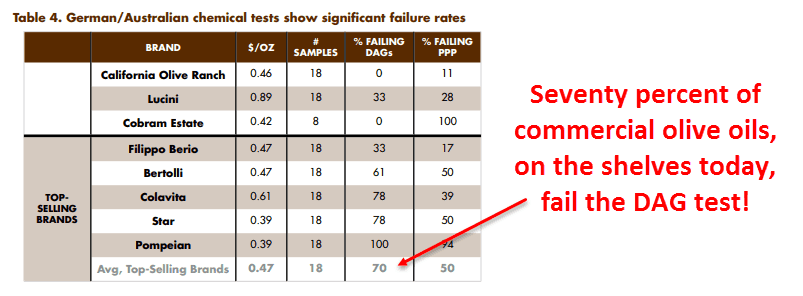
70% failed the “DAG test.”
That number is strikingly similar to the percentage that failed the sensory test performed by the Californian taste testers.
They actually calculated the correlation between the two…
And the taste testers could predict the result of the DAG test with 65% accuracy, or essentially two-thirds of “being always right.”
But is this something to worry about? And WTF does “DAG” even mean?
This acronym stands for diacylglycerides (AKA diglycerides), which exist in small amounts.
These are thought to exist only as a transient metabolite in the living olive, captured just as the oil presser dashes their hopes of becoming triglycerides.
Basically, these are “almost triglycerides.”
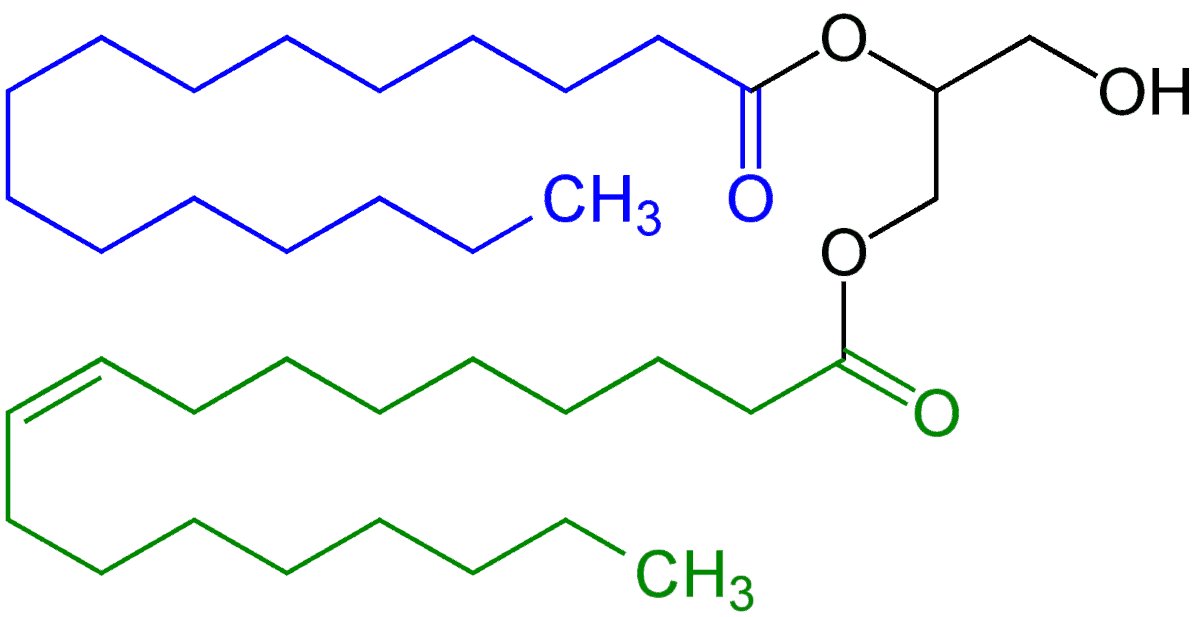
There are three positions on the glycerol backbone.
And when olives are initially pressed, all diglycerides can be found with oleic acid in the 1 and the 2 positions.
But over time or under the influence of heat, the fatty acids spontaneously hydrolyze…
They will actually disconnect from the glycerol backbone and rejoin it at a random position.
So you would expect olive oil extensively stored and/or heated to have more diglycerides connected with the fatty acids in the 1 and 3 positions.
So the DAG test can say whether or not an olive oil should be considered “extra virgin”…
But it cannot tell us anything definitive about whether or not it had been adulterated.
And the other test discussed in this report – the “PPP” test – is even more useless in this regard.
They didn’t even publish the results from the more definitive tests in this report – the report taken as “evidence” for olive oil adulteration by many bloggers.
Here’s what probably happened: They mentally synthesized Tom Mueller’s findings with a presumption of what this report had actually determined.
But the same people actually did publish the results of the other tests in 2010:
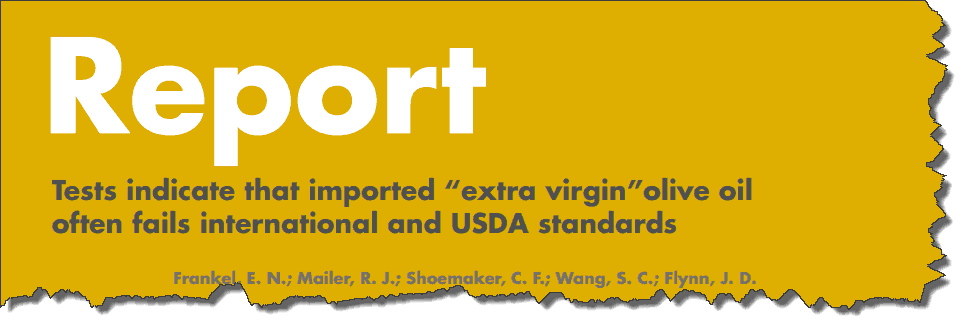
This publication included the results from the other testing techniques they had used:
The free fatty acid analysis, the peroxide value, the UV absorption, the stigmastadiene determination, the fatty acid profile, and the sterols profile.
[cmamad id=”26813″ align=”center” tabid=”display-desktop” mobid=”display-desktop” stg=””]
And the latter two tests in that list can give unambiguous proof of adulteration (or not).
➤ The sterols profile test determines which phytosterols are present.
This can lead to a “dead giveaway” if brassicasterol is detected – because this phytosterol is made only by Brassica species.
And that would prove that rapeseed oil (canola) has been added.
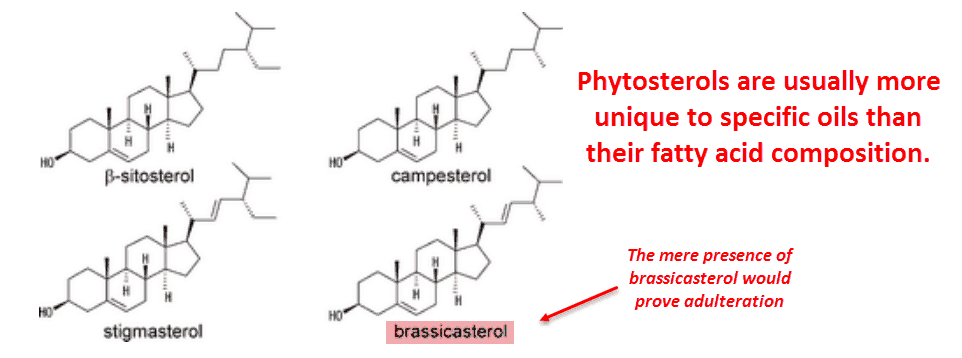
➤ The fatty acid profile can determine additions of between about 7% and 15%, depending on the oil added.
(Hazelnut oil, for example, has a very similar fatty acid profile to olive oil, so it is harder to detect than others.)
“There is no doubt that olive oil adulteration with hazelnut oil is one of the most difficult to detect due to their similar composition…”
Which also means, by the way, that hazelnut oil isn’t all that bad.
Although this is a seed oil, it contains about 80% oleic acid, 10% linoleic acid, and 6% palmitic acid.
So what were the results of these two tests?
Surprise!
They found that these two test values were within range…
Or at least everything that couldn’t easily be explained by bad shipping technique or prolonged storage was in range:
“If any of the samples were adulterated, it is most likely that the adulterant was refined olive oil rather than refined nut, seed, or vegetable oils. Unless the adulteration levels were very small, the failed samples would not have met the IOC/USDA standards for fatty acid profile and sterol profile if adulterated with refined nut, seed, or vegetable oils.”
So, although the first U. Cal. Davis article induced internet shockwaves of sensational headlines trumpeting “70% Olive Oil Fake!!” and “Most Olive Oil Adulterated”…
The actual chemical analysis implies that most olive oils are actually real.
Or at the least, most are only minimally adulterated.
If significant additions of any other oil had been added, the fatty acid ratio would have been unbalanced.
And the sterol profile would have been unbalanced as well.
This was not the case.
That’s not to say the “agromafia” doesn’t exist.
But, according to this study, it’s not messing with olive oil as badly as the Internet thinks it is…
It seems that the fraudulent activity is more about quality than about adulteration.
Regardless, I think you’d have to agree that most imported olive oil is old and not as good as what you’d get living near an olive grove.
You can buy California olive oil online – and it is affordable.
But coconut oil is even healthier.
And it is so cheap that nobody can profit from adulterating it.
(Adulterated coconut oil would be immediately obvious anyway, based on the iodine value and melting point alone.)
—-Important Message—-
Put a few drops of this on your scrotum for an instant boost in penis size.

All men have to do is paint a little of this natural oil on their scrotum…
Once this oil comes into contact with the testicles, the Leydig cells start producing more testosterone…
And then other important male hormones increase too.
Then, before you know it, you are growing a bigger and fatter penis right before her eyes…
Just paint it on and watch it grow…
———-

- Frankel, E. "Evaluation of extra-virgin olive oil sold in California." UC Davis Olive Center at the Robert Mondavi Institute (2011)
http://olivecenter.ucdavis.edu/media/files/report041211finalreduced.pdf - Frankel, E. "Tests indicate that imported “extra virgin” olive oil often fails international and USDA standards." UC Davis Olive Center (2010)
http://olivecenter.ucdavis.edu/media/files/oliveoilfinal071410updated.pdf - Mueller, T. “Slippery Business: The Trade in Adulterated Olive Oil.” The New Yorker (2007)
https://www.newyorker.com/magazine/2007/08/13/slippery-business - Arvanitoyannis, I "Implementation of physicochemical and sensory analysis in conjunction with multivariate analysis towards assessing olive oil authentication/adulteration." Critical reviews in food science and nutrition (2007)
http://tandfonline.com/doi/abs/10.1080/10408390600846325 - Garcia, R. "Putative markers of adulteration of extra virgin olive oil with refined olive oil: Prospects and limitations." Food research international (2013)
http://sciencedirect.com/science/article/pii/S0963996913002925
- Olive oil
https://www.betterhealth.vic.gov.au/health/healthyliving/olive-oil - Olive oil tips for consumers
https://olivecenter.ucdavis.edu/learn/olive-oil-tips-for-consumers
